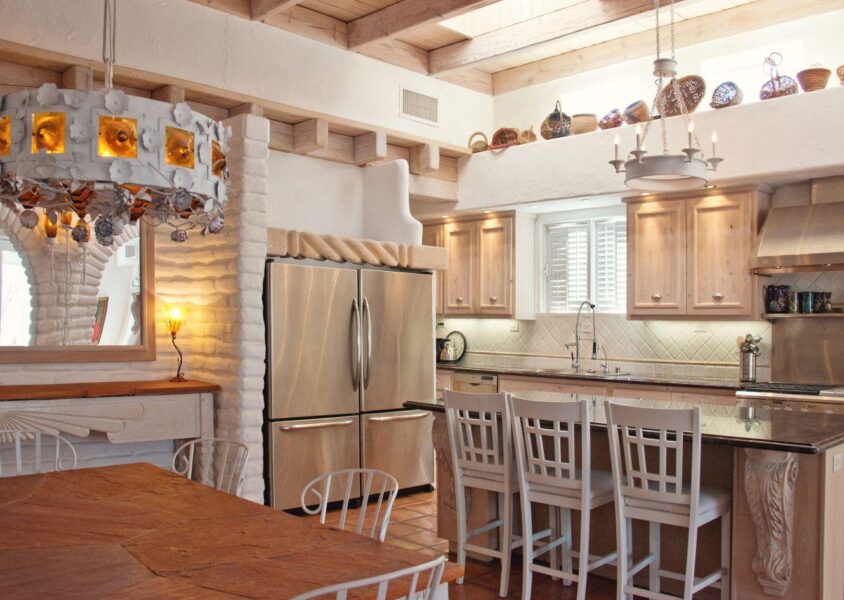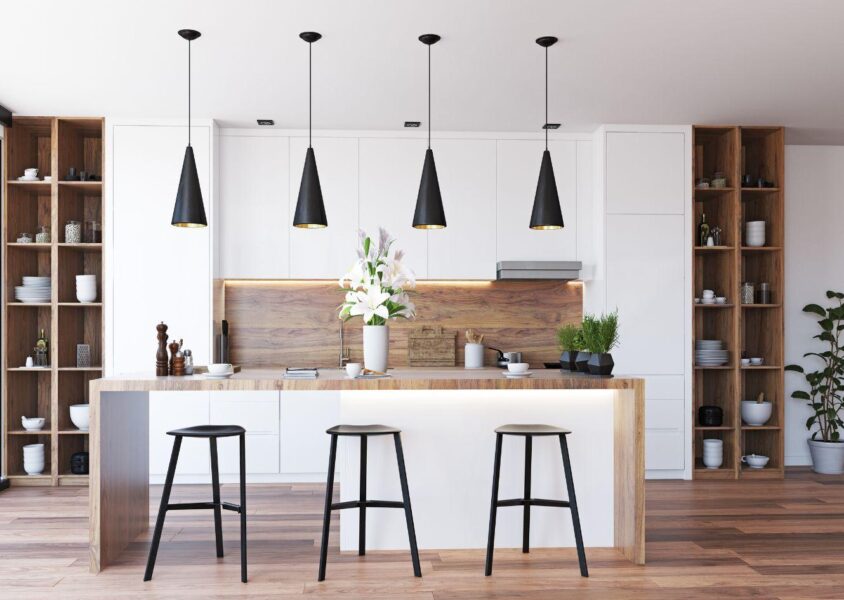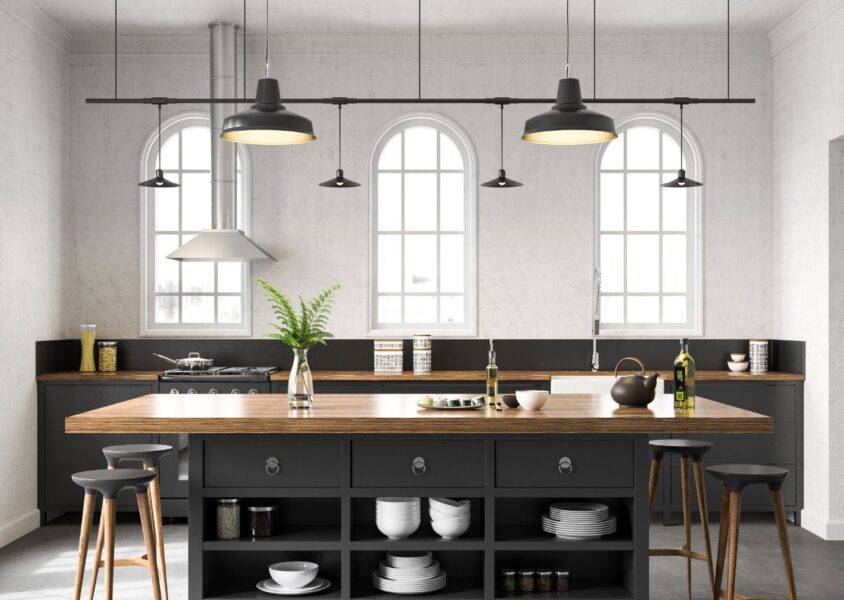Remodeling The Kitchen?

There are many different design trends for kitchens, and these trends can vary depending on your location, personal style, and other factors. Here are a few design trends that have been popular in recent years:
Open concept kitchens
The open concept kitchen trend involves designing a kitchen that is open and connected to the rest of the home, rather than being a separate, closed-off space. This can create a more cohesive and social atmosphere in the home, and can be a good choice for people who enjoy entertaining or who want to keep an eye on their children while cooking.

To create an open concept kitchen, you can remove walls or doors that separate the kitchen from the rest of the home, and use an open floor plan to connect the space to the living room, dining room, or other areas. You can also use visual cues, such as the use of similar materials or colors, to create a cohesive look between the kitchen and the rest of the home.
One key aspect of open concept kitchen design is the use of kitchen islands or peninsulas, which can serve as a visual and functional divide between the kitchen and the rest of the home. These features can provide additional counter space, storage, and seating, and can help to define the kitchen as a separate area within the open concept layout.
Open concept kitchens can be a great choice for people who want a more social, cohesive look in their home, but it’s important to consider the potential drawbacks of this style, such as a lack of privacy and the need for more frequent cleaning and maintenance.
Minimalist design
Many people are opting for a minimalist, streamlined look in their kitchens, with a focus on clean lines and a lack of clutter. In the kitchen, this can involve using a limited color palette, choosing simple, geometric shapes for cabinets and other fixtures, and minimizing decorative elements.
One way to achieve a minimalist look in the kitchen is to focus on the basics and eliminate unnecessary elements. This can involve opting for understated, monochromatic color schemes and choosing high-quality, timeless materials that will stand the test of time.

Another key aspect of minimalist design is functionality. A kitchen that is designed with minimalism in mind should be easy to use and maintain, with everything in its place and no unnecessary items taking up space. This can involve using hidden storage solutions, such as pull-out pantries and built-in organizers, to keep the space clutter-free.
A minimalist kitchen can create a sense of calm and order, and can be a very practical and functional space to work in. However, it’s important to keep in mind that minimalism is a personal choice, and what works for one person may not work for another. It’s important to consider your own needs and preferences when designing a kitchen, and to find a balance that works for you.
Industrial style
This trend involves incorporating industrial-inspired elements, such as exposed brick walls, concrete countertops, and metal accents, into the kitchen design. This style can create a rugged, urban feel, and can be a good choice for people who want to add a touch of edginess to their kitchen.

To achieve an industrial look in the kitchen, you can use raw, unfinished materials such as brick or concrete, and pair them with metallic accents such as stainless steel appliances or industrial-style light fixtures. You can also incorporate industrial-inspired furniture, such as bar stools made of metal or reclaimed wood, to complete the look.
It’s important to keep in mind that industrial style is a broad term, and can range from a very polished, modern look to a more rustic, vintage feel. You can customize the style to fit your personal preferences and the overall design of your home.
Industrial style can be a great choice for people who want a unique, urban look for their kitchen, but it’s important to consider the practicality of the materials and features you choose. Raw materials such as brick and concrete may require more maintenance and care than other options, and metal accents may not be suitable for all climates.
Natural materials
Using natural materials, such as wood, stone, and marble, in the kitchen can add warmth and texture to the space. This trend can involve using these materials for countertops, backsplashes, and other features.
Wood can be used for cabinetry, countertops, backsplashes, and other features in the kitchen, and can add a natural, rustic feel to the space. Different types of wood can have different looks and characteristics, so it’s important to consider the pros and cons of different options. For example, hardwood cabinets can be more expensive and require more maintenance than cabinets made of other materials, but they can also add a lot of warmth and character to the kitchen.
Stone, such as granite or quartz, can be a popular choice for countertops, backsplashes, and other features in the kitchen. Stone is durable and resistant to heat and stains, and can come in a wide range of colors and patterns. Marble is another option for kitchen countertops, but it is more prone to staining and scratching than other types of stone, and may require more maintenance.
Using natural materials in the kitchen can create a warm, inviting atmosphere, and can be a good choice for people who want a cohesive, organic look in their home. However, it’s important to consider the maintenance and care requirements of different materials, as well as their cost and durability.
Smart technology
The use of smart technology in the kitchen is a growing trend that can make the space more convenient and efficient to use. Some examples of smart technology that can be incorporated into kitchen design include:
Voice-controlled appliances: Smart appliances, such as refrigerators and ovens, can be controlled using voice commands through a virtual assistant, such as Amazon’s Alexa or Google’s Assistant. This can make it easier to use these appliances and can be especially useful for people who are busy or have mobility issues.
Touchless faucets: Touchless faucets can be activated using motion sensors, which can help to reduce the spread of germs and make the kitchen more hygienic. These faucets can also be more convenient to use, as you don’t have to touch them to activate the flow of water.
Smart lighting: Smart lighting systems can be controlled using a smartphone app or voice commands, and can allow you to adjust the brightness and color of the lighting in your kitchen. This can be especially useful for tasks such as cooking and food prep, when different levels of lighting may be needed.
Smart thermostats: Smart thermostats can be controlled using a smartphone app or voice commands, and can allow you to adjust the temperature in your kitchen remotely. This can be especially useful if you want to preheat the oven or turn down the heat while you’re away from home.
The use of smart technology in the kitchen can make the space more convenient and efficient to use, and can be a good choice for people who are looking for a more modern, high-tech look in their kitchen. However, it’s important to consider the cost and maintenance requirements of different smart technology products, as well as whether they will meet your needs and preferences.
These are just a few examples, and there are many other design trends that may be popular in different areas and among different people.